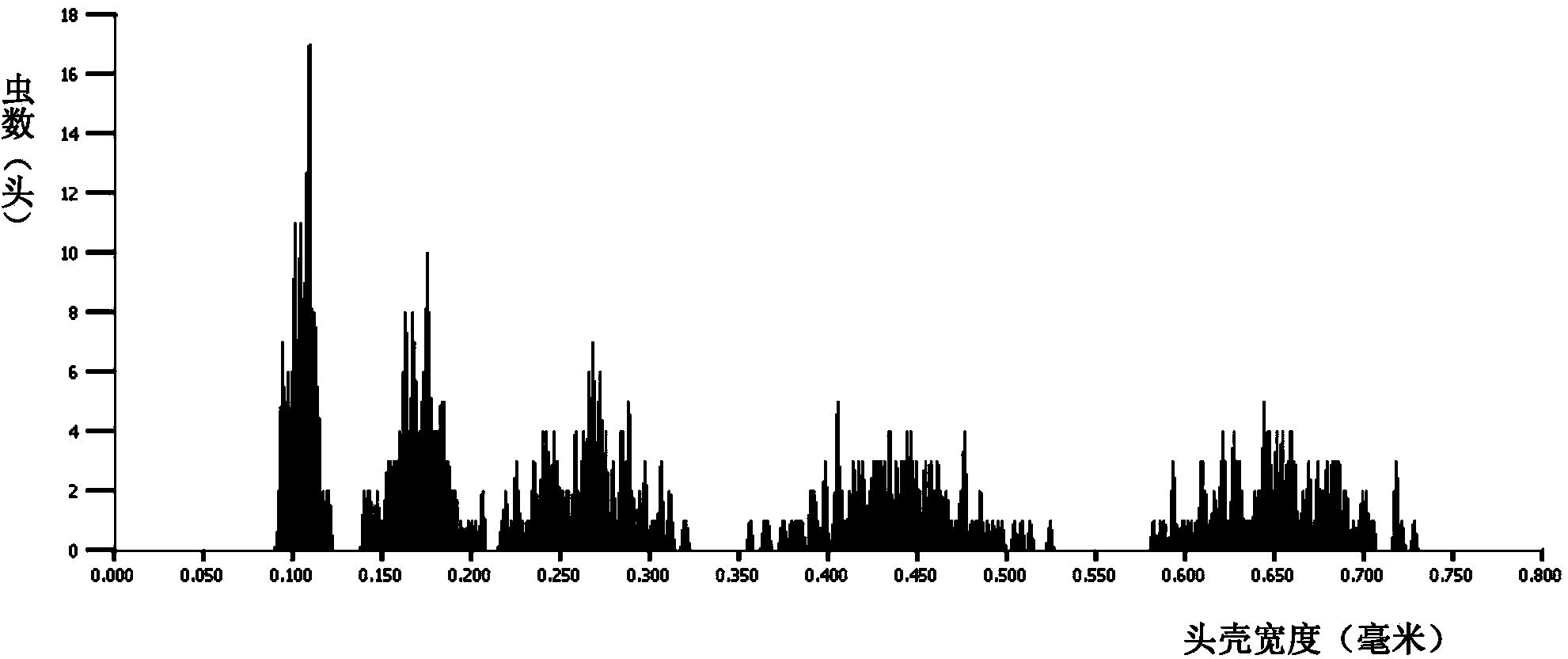Conopomorpha sinensis Bradley forecasting method
A litchi pedicle borer and litchi technology, applied in the field of pest prediction and forecasting, can solve the problems of short prediction time span, difficulty in collecting insect body samples, and increase the prediction time span, so as to increase the prediction time span, save time, and increase the prediction time Effect
- Summary
- Abstract
- Description
- Claims
- Application Information
AI Technical Summary
Problems solved by technology
Method used
Image
Examples
Embodiment 1
[0021] Embodiment 1: Determination of instars and age-grading standards of litchi pedicle borer larvae
[0022] The number of instars and the age classification standard of litchi pedicle borer larvae are one of the basic data required by the present invention. Without this set of basic data, the number of pedicle borer larvae cannot be counted according to different ages, and the main insect state cannot be determined, so that the adult occurrence period cannot be estimated from larvae. Regarding the number of instars of litchi pedicle moth larvae, it was first proposed by He Heping (1986) that according to the width of the larval head shell, the larvae are divided into 4 instars (How Equal, Journal of South China Agricultural University, Vol.7.NO.1, pp43 -53, 1086). Huang Zhensheng et al. (1989) also believed that the larvae of the litchi pedicle borer were divided into 4 instars, and measured the head shell width of the 1st to 4th instar larvae. The instar larvae are 0.66...
Embodiment 2
[0030] Example 2: Determination of the developmental period of each instar larvae of litchi pedicle borer under different temperature conditions
[0031] The development period of each instar larvae of litchi pedicle borer under different temperature conditions is another set of basic data required by the present invention. Without this set of basic data, when estimating the peak period of adults, the data cannot be substituted into the calculation, and the calculation is out of the question. To this end, we determined the developmental duration of each instar larvae of the litchi pedicle borer at 14 to 38°C. Methods as below:
[0032] S1. Determination of egg stage of litchi pedicle borer under different temperature conditions
[0033] For the constant temperature test, 9 temperature gradients were set: 14, 17, 20, 23, 26, 29, 32, 35 and 38°C. After the lychee pedicle moth becomes a moth and lays eggs, the egg card is put into a petri dish, and each petri dish has 30 eggs....
Embodiment 3
[0058] In order to verify the application effect of the present invention, we simultaneously use the following two methods to predict the peak period of litchi pedicle borer adults in the same orchard. Among them, method 1 is a method developed by predecessors, that is, a pupation progress prediction method, and method 2 is the method of the present invention. The specific operation steps are as follows:
[0059] Method 1: During the mid-term fruit drop period, collect fallen lychee fruit from the litchi orchard at Baiyun Base, Zhongluotan Town, Baiyun District, Guangzhou, bring them back indoors, place them on a plastic square tray, and spread them in a single layer to avoid overlapping of fallen fruits. Cut the B-type corrugated paper to a suitable size and completely cover the square plate. Change the corrugated paper every day and record the number of pre-pupae and pupae of the pedicle moth on the corrugated paper until no larvae pupate. Then, calculate the pupation rate...
PUM
 Login to View More
Login to View More Abstract
Description
Claims
Application Information
 Login to View More
Login to View More - Generate Ideas
- Intellectual Property
- Life Sciences
- Materials
- Tech Scout
- Unparalleled Data Quality
- Higher Quality Content
- 60% Fewer Hallucinations
Browse by: Latest US Patents, China's latest patents, Technical Efficacy Thesaurus, Application Domain, Technology Topic, Popular Technical Reports.
© 2025 PatSnap. All rights reserved.Legal|Privacy policy|Modern Slavery Act Transparency Statement|Sitemap|About US| Contact US: help@patsnap.com



